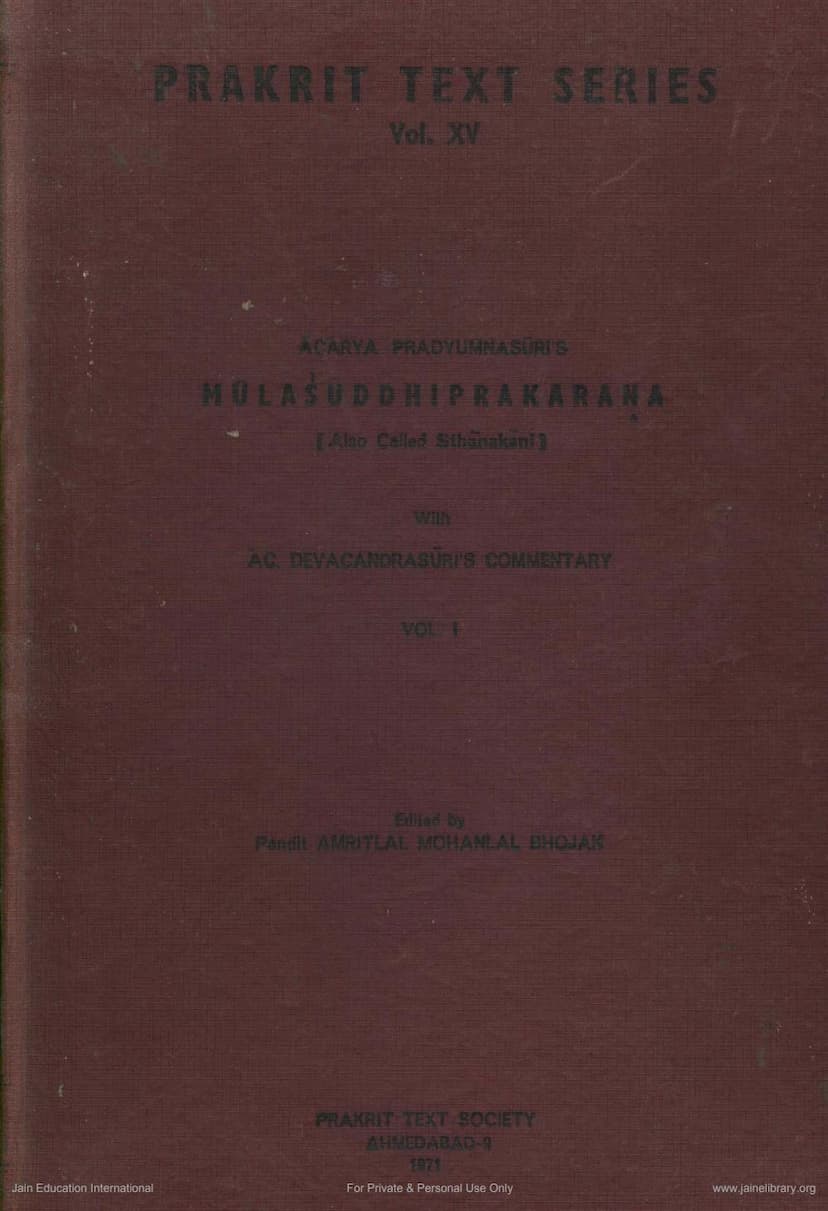Mulshuddhiprakarana
Added to library: September 2, 2025

Summary
This is a comprehensive summary of the Jain text "Mūlaśuddhiprakaraṇa" by Ācārya Pradyumnasūri, with the commentary of Ācārya Devacandrasūri, as presented in the provided pages.
Overall Context:
- Title: Mūlašuddhiprakaraṇa (also called Sthānakani)
- Author: Ācārya Pradyumnasūri
- Commentator: Ācārya Devacandrasūri
- Publisher: Prakrit Text Society, Ahmedabad
- Year of Publication: 1971 (Volume I)
- Editor: Pandit Amritlal Mohanlal Bhojak
- Nature of the Work: A Jain religious and didactic tract prescribing duties for Jain believers concerning sacred images, temples, texts, and the fourfold Samgha (monks, nuns, male and female lay followers). The commentary by Devacandrasūri is particularly valuable as it contains numerous religious tales (Akhyānakas, Kathānakas, Udāharaṇas), making it similar to a Kathākośa (treasure of tales).
Key Aspects and Content of Volume I (as per the preface):
-
Authors and Lineage: Pradyumna Sūri was the author from the Pūrṇatalla Gaccha, living in the 11th century. Devacandra Sūri, his disciple (and disciple of Gunasena Sūri, who was Pradyumna Sūri's disciple), wrote the commentary. Devacandra Sūri is also known as the guru of the renowned Hemacandrācārya.
-
Structure of the Work: The Mūlašuddhiprakaraṇa itself focuses on the purity of principles, especially concerning the duties of Jain practitioners.
-
Value of the Commentary (MC):
- Rich in Narratives: The commentary contains a significant number of religious tales, linking it to the Kathākośa tradition. The first volume alone includes thirty-four (or thirty-six with subtales) tales.
- Study of Tale Motifs: These tales are valuable for researching tale motifs and types, both Indian and non-Indian.
- Sources and Parallels: They are crucial for tracing the sources and parallels of widely circulated Jain narratives.
- Notable Stories Included: Stories of Mūladeva, King Samprati (along with Candragupta and Chanakya), Kālakācārya, Khapuṭācārya, Candanā, Ārdrakumāra, Raubiṇeya, Kṛtapunya, and Ārāmasobhā are featured.
- Evolution of Narratives: The commentary allows for tracing the evolution of these stories in correlation with changing cultural conditions across different periods.
- Scholarly Attention: Some of these stories, like those of Mūladeva, Kālakā, and Ārāmasobhā, have already received scholarly attention, but the commentary provides new material or revisions for existing studies. For example, the Ārāmasobhā story in MC predates the earliest known Sugandhadaśamī, requiring a revision of previous views on influence and potentially impacting the origin of the Cinderella motif.
- Influence on Later Works: Several Jain authors have drawn inspiration or borrowed liberally from the stories in MC. Examples include Samghatilaka Sūri reproducing the Kālakā story almost verbatim in his commentary on Haribhadra's Samyaktvasaptati, and the Mūladeva story in MC possibly serving as a source for the version in Kumārapālapratibodha.
- Folk-tale Elements: Some stories clearly exhibit characteristics of folk-tales, such as the origin of Gajāgrapada (mountain name), stories of cuckoldry (Sukasaptati), "You reap what you sow" (Bhima and Mahabhima), and transformations (woodworm couple, monkey couple).
-
Linguistic Significance:
- Apabhraṃśa Content: The commentary includes one entire story, "Sulaśākhyāna" (or Sulaśāsandhi), in Apabhraṃśa, conforming to the Sandhi type of poems in Late Apabhraṃśa. This work is also preserved separately.
- Apabhraṃśa Passages: Numerous short passages in Apabhraṃśa within the commentary are valuable specimens of the language from Hemacandra's time.
- Prakrit Usage: The Prakrit of MC contains numerous words, constructions, and idioms significant for studying Apabhraṃśa and Early Gujarati. The preface provides several examples, highlighting words and forms that shed light on linguistic evolution from the 11th to 14th centuries.
-
Editorial Information (from pages 14-19):
- Manuscript Basis: The edition is based on six manuscripts for the Mūlašuddhi text and five for the commentary. These manuscripts are designated A, B, C, D, and E.
- Details of Manuscripts: The editorial preface provides descriptions of these manuscripts, including their location, material (paper or palm-leaf), dimensions, script quality, content, and estimated dating.
- Editorial Approach: The editor, Pandit Amritlal Mohanlal Bhojak, explains the process of selecting the best readings from the manuscripts, noting variations in the footnotes. He also explains the use of quotation marks for direct speech and other textual conventions.
- Dedication: The book is dedicated to Muni Shri Puṇyavijayji (Āgamaprabhākarji) by his disciple Amritlal, highlighting Puṇyavijayji's role in the editing process.
- Publisher's Gratitude: The Prakrit Text Society expresses gratitude to Muni Jinavijayaji for initiating the publication and to Shri Dal Sukh Malvania for his support in bringing out the remaining portion of the text.
- Errata: A list of errata (Shuddhipatrakam) is provided for the first volume, indicating corrections to be made in the text.
Core Themes and Purpose:
The Mūlašuddhiprakaraṇa, especially through its commentary, aims to:
- Instruct Jain Believers: Outline the essential duties and principles for maintaining purity in Jain practice.
- Promote Right Faith (Samyaṅgdarśana): Emphasize the importance of right faith and the means to attain and preserve it.
- Illustrate with Stories: Use a rich collection of narratives to make religious teachings accessible and memorable, illustrating virtues and vices, and the consequences of actions.
- Preserve and Disseminate Jain Literature: The publication itself is a scholarly effort to bring an important Prakrit text with its commentary to light for academic and personal study.
In essence, the Mūlašuddhiprakaraṇa with Devacandra Sūri's commentary is a foundational Jain text that combines doctrinal instruction with a vibrant tradition of storytelling, offering insights into Jain life, beliefs, and the evolution of its literature and language.